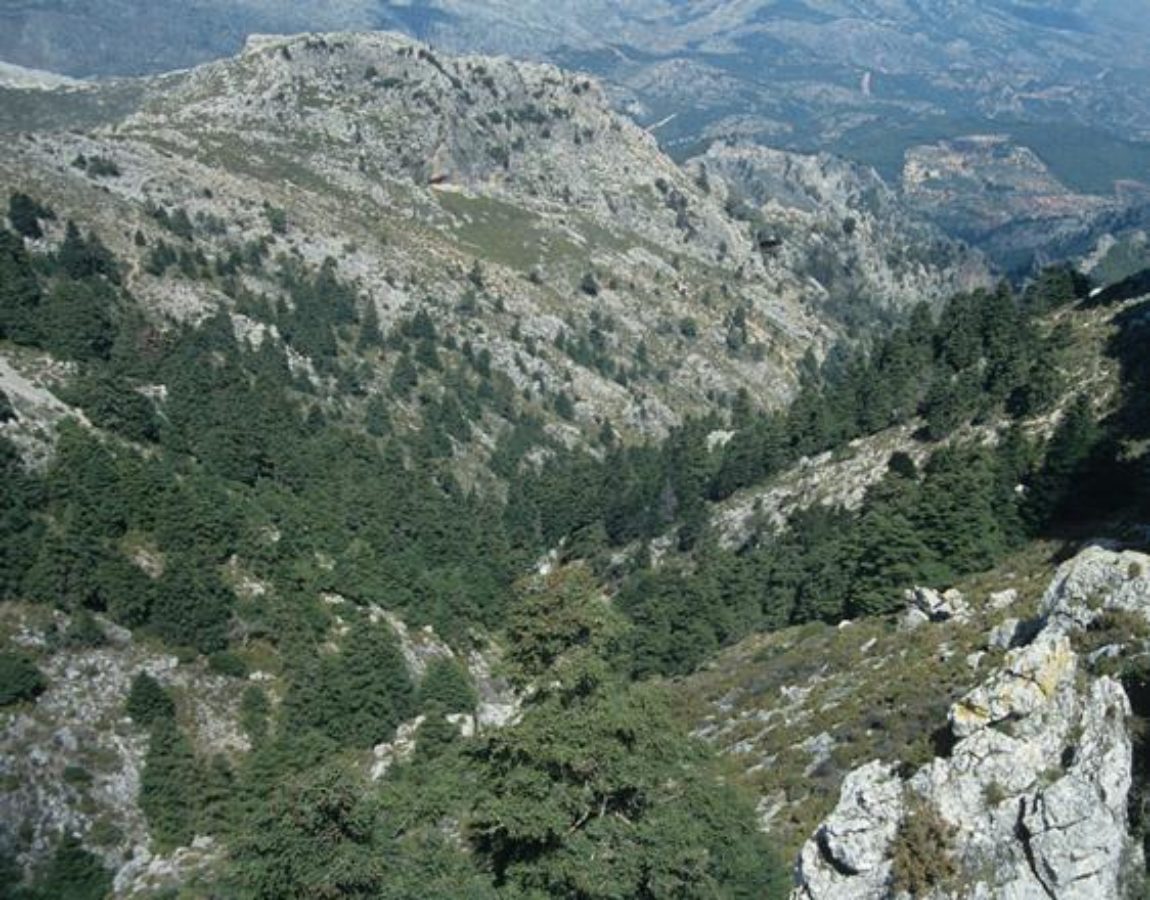Pinaceae
Abies pinsapo
The Spanish fir has two subspecies distributed in southern Spain and northern Morocco where threats include fire, grazing and climate change.
Description
Habit
Tree to 30m tall, d.b.h. 1–1.5m; trunk straight but sometimes forked or twisted; crown narrowly conical in young trees and irregular in mature trees. Bark smooth and dark grey in young trees, rough and scaly in old trees. Branches, lower curved downwards, uppermost ascending, branchlets very rigid, reddish brown or greenish brown, vegetative buds ovoid–globose, 5–-6 x 4–4.5mm, greenish to purple-brown.
Foliage
Leaves spirally arranged all around shoot, those below bent backwards; 1–1.8cm, leathery, stiff, bluntly rounded; dull grey–green or blue–grey with two broad stomatal bands of grey–green or dull bluish white on each surface.
Cones
Female cones 9–14cm x 3–4cm, abruptly narrowed to apex, greenish purple when immature, ripening dark or light brown. Male cones crowded along underside of shoot, dark brown, opening cherry–red.
Notes
Abies pinsapo comprises A. pinsapo var pinsapo, native to southern Spain and A. pinsapo var. marocana, native to north Morocco. These are treated on separate pages.
References and further reading
- Arista, M. (1995) The structure and dynamics of an Abies pinsapo forest in southern Spain. Forest Ecology & Management, 74, 81–89
- Arista, A., Alaoui, M.L., Knees, S. & Gardner, M. 2011. Abies pinsapo. In: IUCN 2012. IUCN Red List of Threatened Species. Version 2012.2. . Downloaded on 07 March 2013.
- Arista, M., Herrera, F.J. & Talavera, S. (1997). Biología del Pinsapo. Junta de Andalucía, Consejería del Medio Ambiente, Seville, Spain.
- Arista, M., Talavera, S. & Herrera, F.J.(1997). Abies pinsapo: a protected especies in a protected area. Bocconea. 7: 421-436.
- Aussenac, G. (2002). Ecology and ecophysiology of circum-Mediterranean firs in the context of climate change. Annals of Forest Science, 59, 823–832.
- Barbey, A. (1931). A Travers les Forêts de Pinsapo d’Andalousie: Étude de Dendrologie, de Sylviculture et d’Entomologie Forestière. Librairie Agricole, Paris, France.
- Boudy, P. (1931). Economie forestière nord-africaine. Description forestière du Maroc. 3. Rabat
- Direction Provinciale de l'Agriculture (DPA). (1994). Potentialités et développement agricole dans la Province de Chefchaouen. Unpublished internal report. Direction Provinciale de l'Agriculture, Chefchaouen
- Emberger, L. (1939). Aperçu général sur la végétation du Maroc. Veröffentlichungen des Geobotanischen Instituts, Eidgenössische technische Hochschule Rübel in Zürich 14: 40-157.
- Esteban, L.G., De Palacios, P. and Rodriguez-Losada Aguado, L. (2010). Abies pinsapo forests in Spain and Morocco: threats and conservation. Oryx 44(2): 276-284.
- Fennane, M. & Ibn Tattou, M. (2005). Flore vasculaire du Maroc : inventaire et chorologie. Trav. Inst. Sci. Rabat, Rabat.
- Fennane, M., Ibn Tattou, M., Mathez, J., Ouyahya, A. & El Oualidi, J. (1999). Pteridophyta Gymnospermae, Angiospermae (Lauraceae-Neuradaceae), Flore pratique du Maroc: manuel de détermination des plantes vasculaires, Vol. 1. Rabat Institut Scientifique, Rabat.
- Génova Fuster, M. (2007). El crecimiento de Abies pinsapo y el clima de Grazalema: aportaciones dendroecológicas. Investigación Agraria: Sistemas y Recursos Forestales 16(2): 145-157.
- Hmamouchi, M. (1999). Les Plantes Medicinales et Aromatiques Marocaines. Imprimerie de Fedala, Mohammedia, Morocco.
- Knees, S.G. (2011). Phylogeny, Systematics and Conservation of Abies, especially those around the Mediterranean Basin. Reading. Unpublished PhD Thesis, University of Reading.
- Linares, J.C., Camarero, J.J. and Carreira, J.A. (2009). Interacting effects of changes in climate and forest cover on mortality and growth of the southernmost European fir forests. Global Ecology and Biogeography 18: 485-497.
- Mehlman, P. (1984). Aspects of the ecology and conservation of the Barbary macaque in the fir forest habitats of the Moroccan Rif mountains. In Fa, J. The Barbary Macaque. Plenum Press, London. 165-199
- Moore, H.M., Fox, H.R., Harrouni, M.C. & El Alami, A. (1998). Environmental challenges in the Rif mountains, northern Morocco. Environmental Conservation 25(4): 354-365.
- Quezal, P. (1983). A system of terrestrial biosphere reserves for the Mediterranean, in : UNESCO Man and the Biosphere (MAB) Programme, First International Biosphere Reserve Congress. MINSK-BSSR-USSR, 26 September-2 October 1983.
- Royaume du Maroc (1996). Census nationale. Database. Direction de la Statistique. Rabat, Morocco.
- Terrab, A., Talavera, S., Arista, M., Paun, O., Stuessy, T. F. & Tremetsberger, K. (2007). Genetic diversity at chloroplast microsatellites (cpSSRs) and geographic structure in endangered West Mediterranean firs (Abies spp., Pinaceae). Taxon 56(2): 409-416.
- Valdés, B., Rejdali, M., Achhal El Kadmiri, A., Jury, S. L. & Montserrat, J. M. (2002). Catalogue des plantes vasculaires du nord du Maroc, incluant des clés d’identification, vol. 1. Consejo Superior de Investigaciones Científicas. Madrid.











